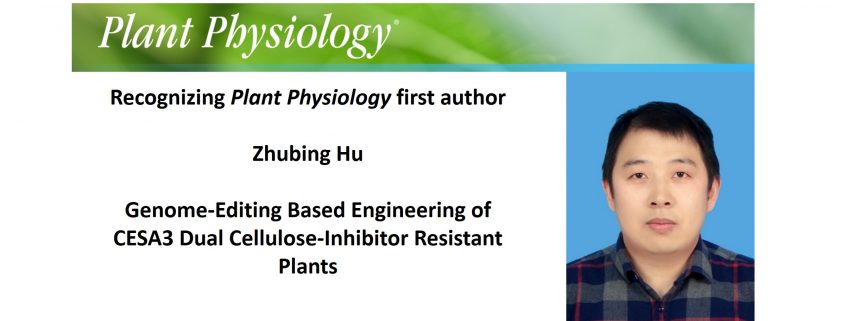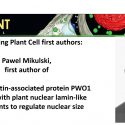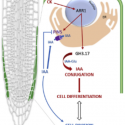Recognizing Plant Physiology first authors: Zhubing Hu
Zhubing Hu, first author of Genome-Editing Based Engineering of CESA3 Dual Cellulose Inhibitor Resistant Plants
Current Position: Principal Investigator, Key Laboratory of Plant Stress Biology, State Key Laboratory of Cotton Biology, School of Life Sciences, Henan University, Kaifeng, China
Education: PhD: Plant developmental Biology, Institute of Botany, Chinese Academy of Sciences, Beijing, China
Non-scientific Interests: Badminton, hiking, and PC games
Brief bio: As a general theme over my career, I was always interested in studying and understanding the survival strategies employed by plants to cope with hostile environments. At my master stage, I joined Prof. Zhenguo Shen’s lab at Nanjing Agricultural University to investigate the mechanisms by which plants cope with heavy metal stress. After an excellent training and activated curiosity in Shen’s Lab, I started a PhD training in Prof. Yuxin Hu’s lab (Institute of Botany, Chinese Academy of Science), focusing on the identification of novel components controlling plant organ size using genetic and molecular approaches. Four-and-a-half-years of patient guidance from Prof. Hu have raised me up as a well-trained researcher. From 2010 to 2016, I worked as a postdoctoral researcher in Finland (Prof. Jing Li’s Lab, University of Helsinki) and in Belgium (Prof. De Veylder’s Lab, Gent University-VIB). Thanks to an increased knowledge of different techniques and abilities, and as well high research productivity in both Li’s and De Veylder’s lab, I had the chance to set up my own lab in China. When I was in De Veylder’s lab, my colleagues and I identified a cellulose synthesis inhibitor C17 and unraveled a link between the cell wall and mitochondria. In the light of the arisen world-wide problems related to weed control and the possibility to use C17 as a novel herbicide, this work was initiated. Our data clearly showed that C17 can be developed as a useful herbicide and that its resistance can be obtained through genome engineering using CRISPR-mediated base editing.
胡筑兵 first author of Genome-Editing Based Engineering of CESA3 Dual Cellulose Inhibitor Resistant Plants
目前职位:河南大学植物逆境生物学重点实验室/棉花生物学国家重点实验室/生命科学学院,首席研究员
教育经历:中国科学院植物研究所,植物发育生物学,博士
兴趣爱好:羽毛球、徒步旅行和电脑游戏
科研经历简介:我一直感兴趣的科学问题是植物如何在恶劣的环境条件下幸存。在硕士期间,我加入了南京农业大学沈振国教授实验室从事植物应对重金属胁迫的机制研究。在沈老师实验室,我接受了良好的科研训练,同时也激发了对未知世界的好奇心。随后,我在中国科学院植物研究所胡玉欣研究员实验室攻读博士学位,开启了另一段新的科研征程。期间,主要从事植物器官发育的分子机制的解析。通过胡老师四年半的耐心指导,我已经成长为一个训练有素的科研工作者。在2010年至2016年期间,我分别在芬兰的赫尔辛基大学(李竞实验室)和比利时根特大学-VIB植物生物学研究中心(Lieven De Veylder实验室)从事博士后研究工作。得益于在以上两个实验室期间科研能力的提升以及较高的科研产出,我回国建立了自己的实验。当我在Lieven De Veylder实验室时,我和我的同事鉴定了一个纤维素合成酶抑制剂C17,并且发现线粒体和细胞壁之间存在联系。同时,鉴于世界范围内日益严峻的杂草调控形式以及C17作为除草剂的巨大潜力,我们开启了这项研究工作。通过此项研究,我们清楚地展示C17可以被开发成一个有用的除草剂,并且C17的抗性植株可以通过CRISPR介导的单碱基编辑系统进行基因组编辑获得。




